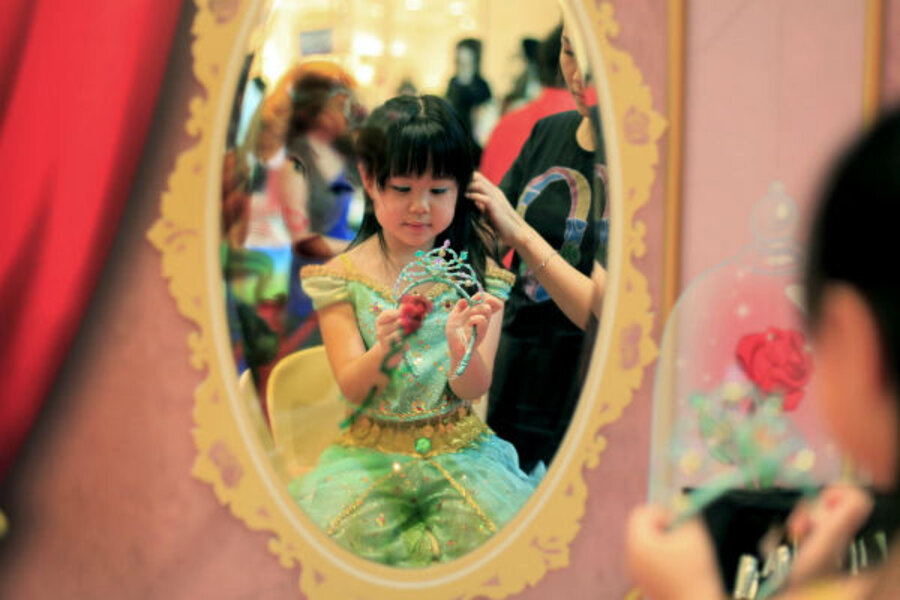Disney Princess paint: New way for girls to be fashion victims
Loading...
Did you know that Behr produces a line of Disney Princess interior paints?
In fact, Behr has a whole Disney Princess-Disney Color catalog with color names such as Fairest of Them All, Tink Pink, Glamorous Glow, One Enchanted Evening, and Bibbidi Bobbidi Blue.
The catalog describes the Disney Princess bathroom: “Relax in rooms as pretty as a princess. Surround yourself in a setting as cheerful as her smile.”
And, of course, the Disney Princess bedroom: “In Sleeping Beauty’s room, everything is enchanted. What better place to dream?”
Sleeping Beauty’s room, pictured in the catalog, features Disney Princess paints, pieces from the Disney Princess Furniture Collection, Disney Princess bedding, and many other Disney Princess products.
While there seems to be a Disney Princess version of nearly everything, the idea of Disney Princess interior paints may come as a surprise. What’s going on here?
Brands, Megabrands, and Lifestyle Brands: How Disney Princess Works
My students and I recently screened the Media Education Foundation documentary "No Logo," based on Naomi Klein’s book of the same name. In the video, Ms. Klein explains why consumers and critics wind up protesting certain brands.
Klein says that the insidiousness of brand marketing is at the root of most protesters’ concerns. Brands are no longer seeking popularity; instead, Klein says, they “want to be everywhere and be everything.” In so doing, a brand becomes a megabrand.
Because of this outlook, Klein says, megabrands (and megabrand wannabes) regularly ask questions like, ”If it’s a line of clothing, can it be a house paint?”
The answer, of course, is yes. Megabrand Ralph Lauren makes clothes, home goods and, yes, house paints. Even though Ralph Lauren paint looks just like other paints that cost significantly less, the Ralph Lauren brand has enough perceived prestige to make it appealing to brand-conscious consumers.
In this way, megabrands – by being everywhere and being everything – become something even bigger: they transform into lifestyle brands.
Lifestyle brands are brands that permeate every aspect of a consumer’s lifestyle, such that the brand identity is intertwined with the consumer’s personal identity. Virgin is the quintessential lifestyle brand, illustrated by its subsidiaries list, which includes everything from music to travel to wine. A consumer with a strong preference for a megabrand’s products and services may think, “This is my brand,” or “This brand is part of me.”
Disney Princess as lifestyle brand
Like Disney as a whole, the Disney Princess brand has been following the megabrand playbook for years. The result is that in the past decade, Disney Princess has become a lifestyle brand, completely intertwined with little girls’ identities. Disney Princess is not just about the movies and the toys; it’s about food, clothing, and home goods, too. At this point, there are Disney Princess products available for just about every aspect of life, from diapers to wedding dresses.
If Disney wants its princesses to be everything and be everywhere, then of course your home’s walls are in its sights. As a special bonus, the Disney Princess paint catalog is a vehicle for the cross-promotion of other products, like Disney Princess bedding and furniture collection – a nice example of what marketers call “synergy." Jack Wayne, of Demand Media, defined synergy this way:
"When synergy happens, one plus one no longer equals two. It can equal three, four, five or more. Synergy in marketing is when two marketing initiatives create a response greater than the sum of the combined response the two would have elicited alone."
Synergy is basically the holy grail of integrated marketing campaigns – and Disney Princess is absolutely synergistic. As a collective, it’s worth much more than the sum of its parts.
Just check out your local Home Depot for more details on the synergy of the Disney Princess paint line.
The Christian Science Monitor has assembled a diverse group of the best family and parenting bloggers out there. Our contributing and guest bloggers are not employed or directed by the Monitor, and the views expressed are the bloggers' own, as is responsibility for the content of their blogs. Rebecca Hains blogs at rebeccahains.wordpress.com.






